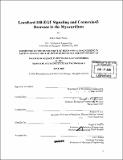Localized HB-EGF signaling and Connexin43 decrease in the myocardium
Author(s)
Prince, Robin Neely
DownloadFull printable version (5.657Mb)
Alternative title
Localized heparin-binding epidermal growth factor signaling and Cx43 decrease in the myocardium
Other Contributors
Massachusetts Institute of Technology. Dept. of Mechanical Engineering.
Advisor
Douglas A. Lauffenburger and Richard T. Lee.
Terms of use
Metadata
Show full item recordAbstract
Growth factor signaling can affect tissue remodeling through autocrine and paracrine mechanisms. Recent evidence indicates that hypertrophic signaling in cardiomyocytes is induced through transactivation of the epidermal growth factor (EGF) receptor by heparin-binding EGF (HB-EGF). Here it is shown that HB-EGF operates in a spatially restricted local circuit in the extracellular space within the myocardium, revealing the critical nature of the local microenvironment in intercellular signaling. In vitro studies demonstrated that HB-EGF acts as an autocrine growth factor in cultures of rat neonatal cardiomyocytes. However, in vivo experiments in adult mouse left ventricles demonstrated that HB-EGF secretion by a given cardiomyocyte leads to cellular hypertrophy in cells overexpressing HB-EGF and in adjacent cells, but not in cells farther away. This highly localized microenvironment of HB-EGF signaling was also demonstrated using 3D morphology to assess cardiomyocyte growth and was predicted by a computational model of HB- EGF diffusion and binding in the myocardium. Additionally, in vitro and in vivo studies demonstrated that HB-EGF promotes loss of the principal ventricular gap junction protein Connexin43 (Cx43) in cardiomyocytes. Thus, HB-EGF acts as an autocrine and local paracrine cardiac growth factor that leads to loss of gap junction proteins within a spatially confined microenvironment within the myocardium. This demonstration of localized intercellular signaling demonstrates how cells can coordinate remodeling with their immediate neighboring cells without affecting others nearby.
Description
Thesis (S.M.)--Massachusetts Institute of Technology, Dept. of Mechanical Engineering, 2005. Vita. Includes bibliographical references (p. 45-48).
Date issued
2005Department
Massachusetts Institute of Technology. Department of Mechanical EngineeringPublisher
Massachusetts Institute of Technology
Keywords
Mechanical Engineering.